Up to date
This page is up to date for Godot 4.2.
If you still find outdated information, please open an issue.
Najlepsze praktyki dla wspierających rozwój silnika¶
Wprowadzenie¶
Godot has a large amount of users who have the ability to contribute because the project itself is aimed mainly at users who can code. That being said, not all of them have the same level of experience working in large projects or in software engineering, which can lead to common misunderstandings and bad practices during the process of contributing code to the project.
Język¶
Zakres tego dokumentu to lista najlepszych praktyk do zastosowania dla rozwijających kod, jak i do tworzenie języka, którego mogą używać w odniesieniu do powszechnych sytuacji, które powstają w procesie oddawania ich zmian.
While a generalized list of software development best practices might be useful, we'll focus on the situations that are most common in our project.
Wsparcie najczęściej jest klasyfikowane jako naprawa błędów, ulepszenia lub nowe funkcjonalności. By uogólnić to pojęcie, nazwiemy je Rozwiązaniami, ponieważ zawsze starają się rozwiązać coś, co można określić jako Problem.
Najlepsze praktyki¶
#1: Problem jest zawsze na pierwszym miejscu¶
Many contributors are extremely creative and just enjoy the process of designing abstract data structures, creating nice user interfaces, or simply love programming. Whatever the case may be, they come up with cool ideas, which may or may not solve real problems.
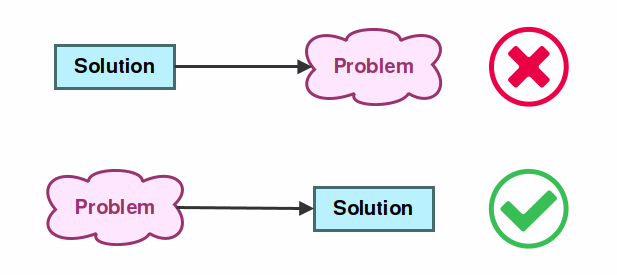
These are usually called solutions in search of a problem. In an ideal world, they would not be harmful but, in reality, code takes time to write, takes up space and requires maintenance once it exists. Avoiding the addition of anything unnecessary is always considered a good practice in software development.
#2: By rozwiązać problem, najpierw musi on istnieć¶
Jest to odmiana poprzedniej praktyki. Dodawanie czegokolwiek niepotrzebnego nie jest dobrym pomysłem, ale co stanowi o tym, co jest potrzebne a co nie?
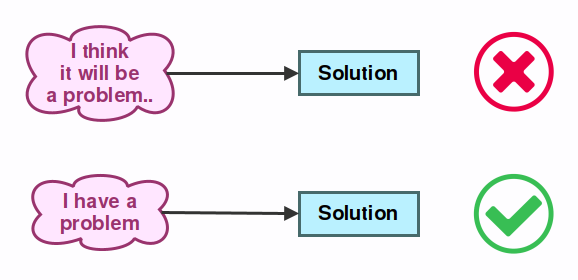
The answer to this question is that the problem needs to exist before it can be actually solved. It must not be speculation or a belief. The user must be using the software as intended to create something they need. In this process, the user may stumble upon a problem that requires a solution to proceed, or in order to achieve greater productivity. In this case, a solution is needed.
Wiara w to, że w przyszłości mogą powstać problemy, oraz że oprogramowanie musi być gotowe do ich rozwiązania zanim się pojawią nazywa się "Zabezpieczeniem na przyszłość" i charakteryzuje się sposobami myślenia takimi jak:
Myślę, że użytkownikom przydałoby się...
Myślę, że koniec końców użytkownicy będą potrzebować...
Ogólnie uważa się to za zły nawyk, ponieważ próba rozwiązania problemów, które obecnie właściwie nie istnieją, często prowadzi do powstania kodu, który będzie napisany ale nigdy nie będzie użyty, lub który jest znacznie bardziej skomplikowany w użyciu i utrzymaniu niż powinien być.
#3: Problem musi być złożony lub częsty¶
Software is designed to solve problems, but we can't expect it to solve every problem that exists under the sun. As a game engine, Godot will help you make games better and faster, but it won't make an entire game for you. A line must be drawn somewhere.
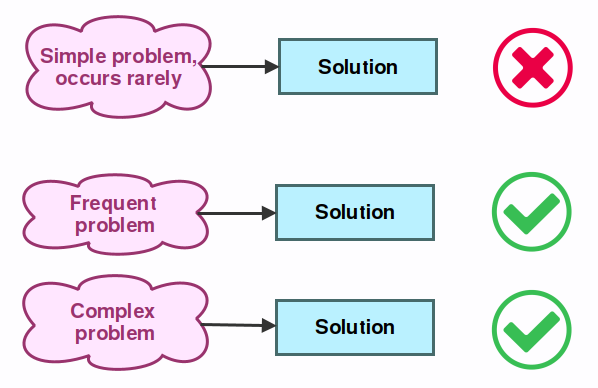
Whether a problem is worth solving is determined by the effort that is required to work around it. The required effort depends on:
Złożoność problemu
Częstotliwość występowania problemu
If the problem is too complex for most users to solve, then the software should offer a ready-made solution for it. Likewise, if the problem is easy for the user to work around, offering such a solution is unnecessary.
The exception, however, is when the user encounters a problem frequently enough that having to do the simple solution every time becomes an annoyance. In this case, the software should offer a solution to simplify the use case.
It's usually easy to tell if a problem is complex or frequent, but it can be difficult. This is why discussing with other developers (next point) is always advised.
#4: Rozwiązanie musi być przedyskutowane z innymi¶
Often, users will be immersed in their own projects when they stumble upon problems. These users will naturally try to solve the problem from their perspective, thinking only about their own use case. As a result, user proposed solutions don't always contemplate all use cases and are often biased towards the user's own requirements.
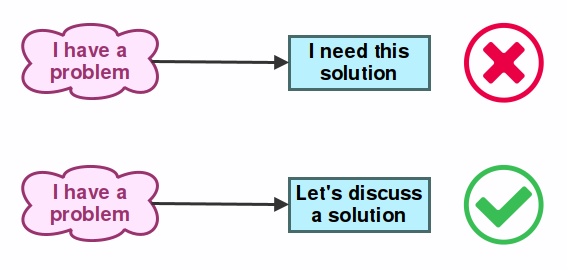
For developers, the perspective is different. They may find the user's problem too unique to justify a solution (instead of a workaround), or they might suggest a partial (usually simpler or lower level) solution that applies to a wider range of known problems and leave the rest of the solution up to the user.
In any case, before attempting to contribute, it is important to discuss the actual problems with the other developers or contributors, so a better agreement on implementation can be reached.
The only exception is when an area of code has a clear agreed upon owner, who talks to users directly and has the most knowledge to implement a solution directly.
Filozofią Godota jest, również, faworyzować łatwość użycia i utrzymania ponad absolutną wydajność. Optymalizacje wydajności będą wzięte pod uwagę, ale nie mogą być zaakceptowane, jeśli czynią coś zbyt trudnym w użyciu lub dodają zbyt dużo zawiłości do bazy kodu.
#5: Do każdego problemu, jego własne rozwiązanie¶
For programmers, it is always a most enjoyable challenge to find the most optimal solutions to problems. It is possible to go overboard, though. Sometimes, contributors will try to come up with solutions that solve as many problems as possible.
The situation will often take a turn for the worse when, in order to make this solution appear even more fantastic and flexible, the pure speculation-based problems (as described in #2) also make their appearance on stage.
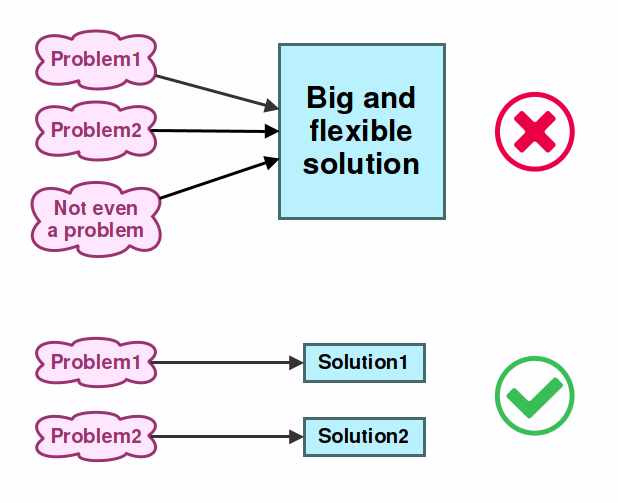
The main problem is that, in reality, it rarely works this way. Most of the time, writing an individual solution to each problem results in code that is simpler and more maintainable.
Additionally, solutions that target individual problems are better for the users. Targeted solutions allow users find something that does exactly what they need, without having to learn a more complex system they will only need for simple tasks.
Big and flexible solutions also have an additional drawback which is that, over time, they are rarely flexible enough for all users. Users end up requesting more and more functionality which ends up making the API and codebase more and more complex.
#6: Cater to common use cases, leave the door open for the rare ones¶
This is a continuation of the previous point, which further explains why this way of thinking and designing software is preferred.
As mentioned before (in point #2), it is very difficult for us (as human beings who design software) to actually understand all future user needs. Trying to write very flexible structures that cater to many use cases at once is often a mistake.
We may come up with something we believe is brilliant but later find out that users will never even use half of it or that they require features that don't quite fit into our original design, forcing us to either throw it away or make it even more complex.
The question is then, how do we design software that both allows users to do what we know they need to do now and allows them to do what we don't yet know they'll need to do in the future?
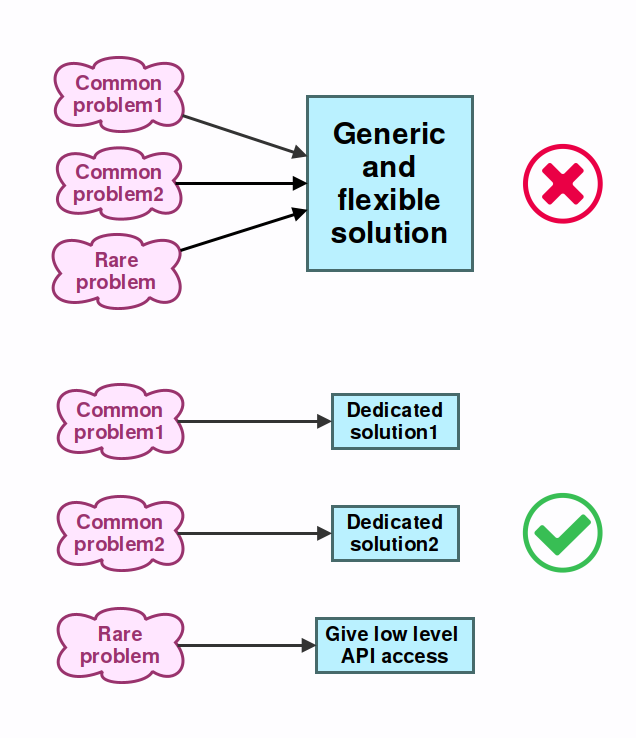
The answer to this question is that, to ensure users still can do what they want to do, we need to give them access to a low level API that they can use to achieve what they want, even if it's more work for them because it means reimplementing some logic that already exists.
In real-life scenarios, these use cases will be at most rare and uncommon anyway, so it makes sense a custom solution needs to be written. This is why it's important to still provide users the basic building blocks to do it.
#7: Prefer local solutions¶
When looking for a solution to a problem, be it implementing a new feature or fixing a bug, sometimes the easiest path is to add data or a new function in the core layers of code.
The main problem here is, adding something to the core layers that will only be used from a single location far away will not only make the code more difficult to follow (split in two), but also make the core API larger, more complex, more difficult to understand in general.
This is bad, because readability and cleanness of core APIs is always of extreme importance given how much code relies on it, and because it's key for new contributors as a starting point to learning the codebase.

A common reason for wanting to do this is that it's usually less code to simply add a hack in the core layers.
Doing so is not advised. Generally, the code for a solution should be closer to where the problem originates, even if it involves additional, duplicated, more complex, or less efficient code. More creativity might be needed, but this path is always the advised one.
#8: Don't use complex canned solutions for simple problems¶
Not every problem has a simple solution and, many times, the right choice is to use a third party library to solve the problem.
As Godot requires to be shipped in a large amount of platforms, we can't link libraries dynamically. Instead, we bundle them in our source tree.
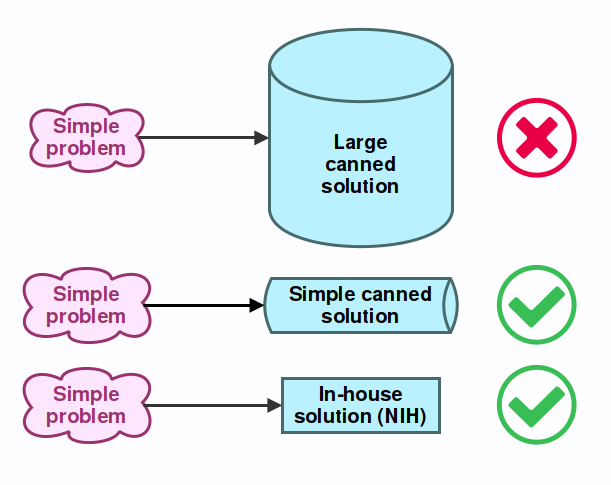
As a result, we are very picky with what goes in, and we tend to prefer smaller libraries (single header ones are our favorite). We will only bundle something larger if there is no other choice.
Libraries must use a permissive enough license to be included into Godot. Some examples of acceptable licenses are Apache 2.0, BSD, MIT, ISC, and MPL 2.0. In particular, we cannot accept libraries licensed under the GPL or LGPL since these licenses effectively disallow static linking in proprietary software (which Godot is distributed as in most exported projects). This requirement also applies to the editor, since we may want to run it on iOS in the long term. Since iOS doesn't support dynamic linking, static linking is the only option on that platform.